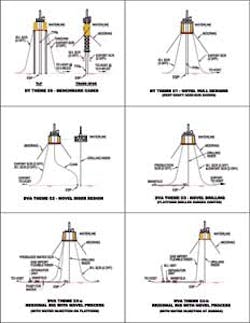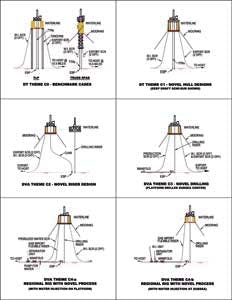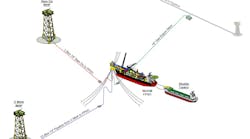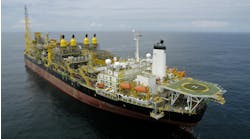R. Aggarwal
D. Barton
Granherne, a KBR Company
R. Seah
Chevron
G. Kusinski
DeepStar/Chevron
The development ofdeepwater fields (< 5,000 ft) in the Gulf of Mexico (GoM) with dry tree (DT) and direct vertical access (DVA) operations have been mostly performed using TLPs and spars. Ultra-deepwater fields (> 5,000 ft) have been developed with spars.
Due to a significant increase in tendon cost with water depth, the use of TLP design, with advantages from low tensioner stroke and quay-side integration of topsides, has remained in the 3,000 ft to 5,200 ft range. The spar design requires long stroke RAM style tensioners and offshore integration of topsides by heavy-lift vessel (HLV). The current qualified limit of top tension riser (TTR) tensioner stroke is 28 ft (design level) for the spar design, and it requires larger hull and mooring sizes to keep the riser tensioner stroke within this limit.
The alternative semisub shaped hull has been used as a production platform in the GoM with tieback of subsea wells at distance. These wells are drilled by a mobile offshore drilling unit (MODU), and tied to the semisub by flexible risers in lesser water depths and by steel catenary risers (SCRs) or steel lazy wave risers (SLWRs) in deeper water depths. One large semisub, theThunder Horse platform, also includes a drilling rig.
The feasibility of platforms in GoM has been further impacted by significant increase in the metocean criteria after Katrina and other hurricanes. The platforms designed to post-2005 (post-Katrina) specifications would require higher deck elevations, greater topsides payload, longer tensioner stroke, more robust station-keeping systems, and larger hull displacements.
The new metocean criteria also led to the division of GoM into three zones (central, transition, western) with varying metocean design data. The new maximum wave height is about 30% higher for the Central GoM and 13% higher for the Western GoM than the pre-2005 criteria. The impact on designs and estimates of TLP, spar, and semisub from new criteria varies. The impact on semisub designs is generally less than on the TLP and spar designs.
The DT or DVA capability is sought to reduce the associated opex when a MODU is mobilized to perform operations such as ESP replacement. The DT capability is obtained with the drilling rig supported on the floating production platform. Alternatively, pre-drilling is performed from a MODU and the floating production platform supports a workover rig in the case of wells below the platform. In the case of subsea wells at distance from the platform, a MODU is required for workover operations. These approaches have provided economic solutions for the development of large fields. In the case of deepwater marginal fields at remote locations with low field life and lower number of production risers, it is desirable that drilling, production, and export functions are undertaken from a single floating platform. Thus lower cost hull and mooring system designs are required for economic viability, which could be obtained by use of semisub hull designs with polyester mooring system. In general, the semisub hull-shaped designs require long stroke RAM tensioners as with a spar platform.
A large number of semisub or hybrid shape hull designs with dry tree capability have recently been developed by various concept owners. These have been evaluated for specific field applications with unique requirements and drivers, or are in various technology development stages. Some of these have been evaluated as dry tree solutions for development of large fields with 12 production risers and a large drilling rig for deeper reservoirs. For two novel hull designs, efforts have been undertaken in RPSEA-funded projects to increase their technology readiness levels (TRL).
The feasibility of several of these novel solutions to provide an economic solution for development of deepwater marginal fields is unknown. Their technical performance in multiple regions and water depths, scalability, constructability, and associated economic factors are important to determine their competitive advantage against proven TLP and spar designs. The evaluation of new designs as enabling solutions, beyond the feasibility of TLP and spar, is required for a combination of water depths, regional parameters, and payloads.
Thus DeepStar funded this project to evaluate a large number of novel concepts for a common design basis, focusing on identification and characterization of key technical performance parameters, constructability, and economic factors. The economic factors are most important for these designs to be considered attractive for development of marginal fields with short field life and fewer wells.
The goal here is to present the alternative development themes for obtaining dry tree and direct vertical access capability, key design basis and design constraints, alternative hull and riser designs considered in various groups for comparative assessment, and important variations among design groups.
Displaying 1/3 Page 1,2, 3Next>
View Article as Single page




